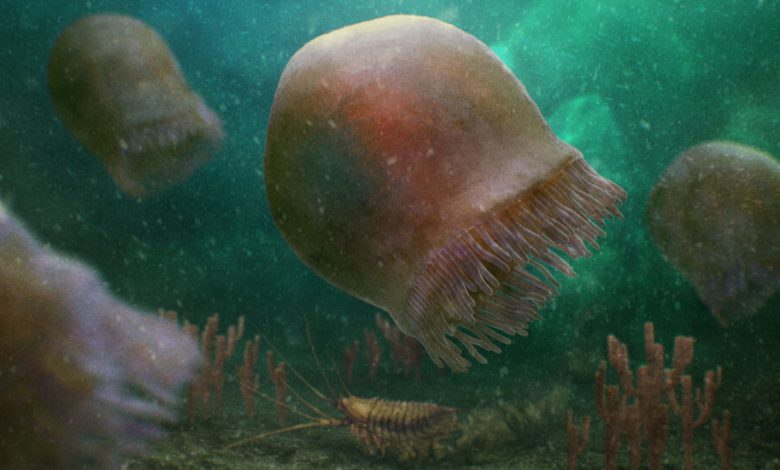505-Million-Year-Old Jellyfish Fossils May Be the Oldest Ever Found

Jellyfish have been floating through Earth’s oceans seemingly forever. But pinning down the exact origin of these squishy sea creatures, which are some of the earliest complex animals, is difficult. They rarely show up in the fossil record because jellyfish are 95 percent water and are prone to rapid decay.
“If you see a jellyfish outside of the water, a couple hours later it’s just a ball of goo,” said Jean-Bernard Caron, a paleontologist at the Royal Ontario Museum in Toronto.
But Dr. Caron and other scientists recently described a cache of jellyfish fossils from the Cambrian period that found an improbable pathway to preservation. In a paper published on Wednesday in the journal Proceedings of the Royal Society B, the scientists posit that these 505-million-year-old animals are among the oldest swimming jellyfish known to science.
“These new fossils represent the most compelling evidence of Cambrian jellyfish to date,” said David Gold, a paleobiologist at the University of California, Davis, who was not involved in the new study.
The jellyfish specimens were found in the Burgess Shale, a fossil-rich site in the Canadian Rockies that provides a glimpse of life during Earth’s Cambrian explosion. Like other soft-bodied creatures found at the site, the gelatinous jellyfish are preserved in stunning detail. Most still possess upward of 90 fingerlike tentacles, which stick out of the creature’s bell-shaped body like the strings at the end of a tassel rug. Some even retain their stomach contents and gonads.
Back in the 1990s, Royal Ontario Museum researchers unearthed more than 170 jellyfish fossils from the Raymond Quarry in British Columbia. When Dr. Caron and a Ph.D. student examined the specimens more recently, they realized the fossils represented a new species, which they named Burgessomedusa phasmiformis.
The species is part of a diverse group called medusozoans, which are thought to have originated at least 600 million years ago and are still swimming in the same seas we know today. But evidence of their rise is scarce. Most fossils from before the Cambrian period are either microscopic or little more than faint imprints, making it difficult to infer how these ancestral jellies lived.
Over the past two decades, paleontologists have discovered several well-preserved jellyfish-like fossils from sites in Utah and China that are similar in ages to the Burgess Shale. However, the true identities of these creatures is still up for debate. In the new paper, Dr. Caron and his colleagues proposed that the fossils from Utah and China represent ancient ctenophores, or comb jellies, another group of gelatinous animals only distantly related to true jellyfish.
Not all researchers are sold by this reclassification. According to Bruce Lieberman, a paleontologist at the University of Kansas who studied the Utah fossils, the new paper lacks compelling evidence to connect the earlier fossils with comb jellies. Instead, he thinks Burgessomedusa joins a swarm of jellyfish species that patrolled Cambrian seas. “It really adds to the compelling body of evidence indicating that medusozoans, which are a really important clade in the oceans today, were already established by the time of the Cambrian period,” Dr. Lieberman said.
The researchers think that adding jellyfish to the Burgess Shale’s miniature menagerie adds another layer of complexity to Cambrian ecosystems. With a body that grew to nearly eight inches long, Burgessomedusa was among the larger creatures around.
According to Dr. Gold, Burgessomedusa’s bell-like shape is reminiscent of modern box jellyfish, which are potent predators that pack a deadly sting. “Box jellyfish are active hunters and use their bell for active reorientation and bursts of speed to go after prey,” Dr. Gold said. However, Burgessomedusa appears to lack several sensory structures found in modern jellyfish. “It’s unclear if it had the eyes modern box jellies use to hunt,” Dr. Gold said.
Even without eyes, Burgessomedusa was likely to have been a top predator. Like modern jellyfish, it probably specialized on smaller fare. But it appears to have also been capable of hunting relatively big game: One Burgessomedusa specimen studied in the paper was preserved with a trilobite lodged inside its bell.
The ability of jellyfish to capture prey while drifting through the sea despite being almost entirely composed of water has made them the oceans’ most enduring predators.
“Burgessomedusa demonstrates how little the basic jellyfish body has changed,” Dr. Gold said. “They have survived relatively unchanged for hundreds of millions of years.”



